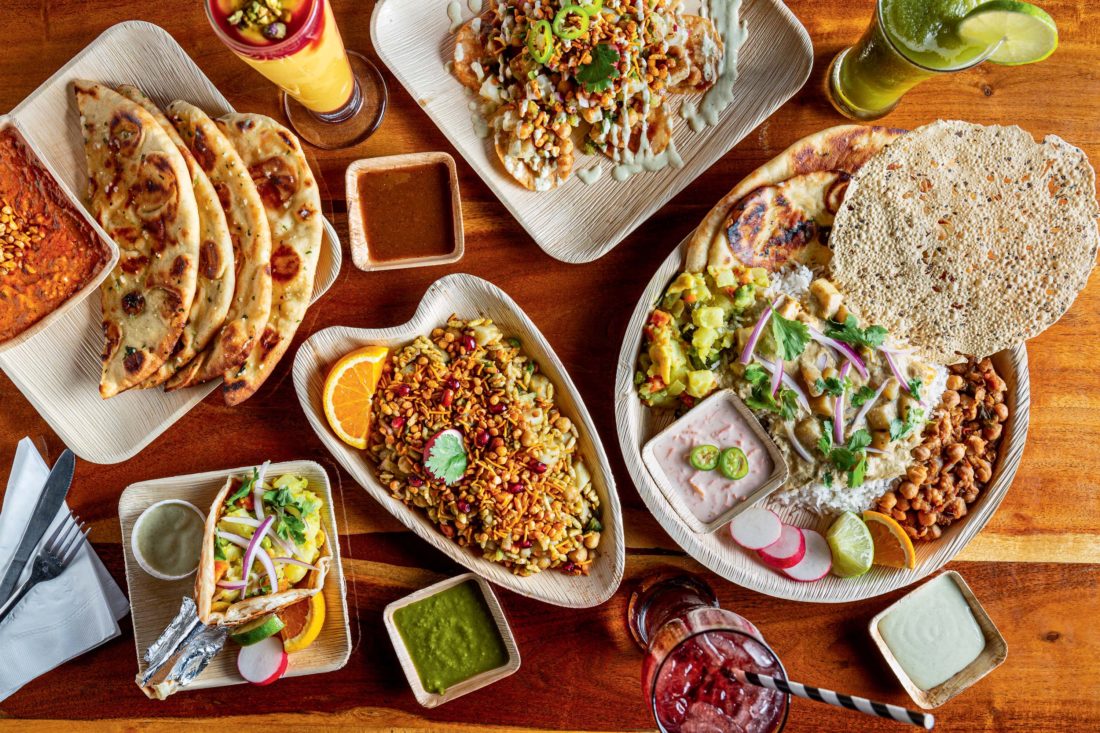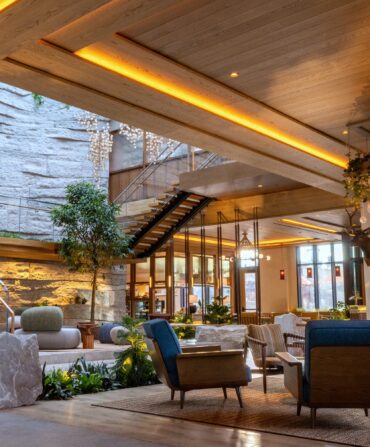Bhel puri was my gateway to the regional cooking of India. Back in the early nineties, I fell for this earthy toss of puffed rice, potatoes, peanuts, chickpeas, chutney, and more. Most likely born of Mumbai, in the state of Maharashtra, the dish is a decadent salad, a sweet, sour, and bright mix of chewy and crispy bits. Now, each time I dine at Khana Indian Grill in Fayetteville, Arkansas, I begin with bhel puri, because the restaurant’s take, served on heart-shaped plates made from pressed palm fronds, does something almost impossible: It tastes better than my memory.
Wife-and-husband proprietors Lisa and Abhijeet Purkayastha imagined Khana to introduce modern Indian cooking to a broad swath of people. Instead of a thick dossier of curried hits from the Indian American playbook, the Khana menu is lean: snacks, rice dishes, rolls, and sides, plus combo plates and one dessert, rice pudding perfumed with cardamom and bergamot. They also serve drinks, including a buoyant mango lassi and an iced coffee laced with cardamom and brightened with orange.
Along with the bhel puri, I like their tikka dip. Served with warm slices of naan, based on the tomatoey sauce that usually drenches chicken tikka, it tastes, in the best possible way, like the money dish from a Mumbai Ruby Tuesday. The Purkayasthas and their crew also make beautiful khati rolls, long popular in Kolkata, in the state of West Bengal, which Abhijeet considers his cultural home. I like the turmeric potato-stuffed version, which comes with cilantro, onion, and mint-yogurt chutney.

The look of Khana is lean, too. If you know how a 1970s Wendy’s looked, with bathrooms tucked at back right and a drive-through window on the left midflank, you will recognize those bones in Khana, which opened in the former fast-food box in 2015 across College Avenue from a new Wendy’s. Lanterns made of punctured metal hang from a blacked-out ceiling. Oversize paisleys frame the order counter.
Lisa, who descends from Choctaw people in Oklahoma, and Abhijeet, who emigrated from the city of Chennai on the Bay of Bengal, met in Houston, where they worked at an advertising agency. They began a leather manufacturing and import business at their dining room table before moving to Fayetteville in 2006. When cheaper Chinese goods flooded the leather market, the couple planned a restaurant that would interpret the foods of Abhijeet’s youth. His mother taught Lisa to cook traditional dishes. That meant learning how to toast and grind whole spices, Lisa told my Southern Foodways Alliance colleague Annemarie Anderson in an oral history interview, and how to mix tapioca pearls with potatoes and peanuts for fritters called sabudana vada.
Northwest Arkansas often gets referred to as NWA. Four cities anchor the tight-knit region of more than five hundred thousand: Fayetteville, Bentonville, Rogers, and Springdale, along with a booming public university and a constellation of smaller towns. Between 2010 and 2019, NWA grew faster than all but twelve metro areas in the United States.
That growth has yielded great complexity, defined over generations by new arrivals who came here in search of work. Late in the nineteenth century, Italian immigrants left the cotton fields of the Delta to farm grapes. Mexican immigrants came in the mid- to late twentieth century to work chicken plants. More recently, South Asian people arrived to work information technology jobs at the locally headquartered Fortune 500 companies Walmart, J. B. Hunt Transport, and Tyson Foods. Cricket leagues play matches on baseball fields, athletes bike old and lush woods on new trails, and two museums—fueled by Walmart’s success and underwritten by Walton family money—have tilted the axis of the contemporary art world. (While benefits have accrued here, you can also argue that Walmart’s pay structures and pricing have had destructive effects elsewhere.)
The positive impacts on NWA food culture have been dramatic. Over the last five years, I’ve traveled here five times to drink pour-over coffees made with single-origin beans, snack on shell-bean hummus, eat dinners of fried chicken and spaghetti drenched in red gravy, enjoy breakfasts of chilaquiles drizzled with sour crema, and savor takeout lunches of goat biryani. That said, the food and drink that now beg my return come from Khana Indian Grill.
After the pandemic began, the Purkayasthas shifted to serve most meals from that old takeout window. This past summer, Khana customers gathered at picnic tables and a clutch of Adirondack chairs, set in the grass apron out front, where pots of wildflowers and shrubs served as dividers between virtual booths. Umbrellas made in the state of Rajasthan, decorated with mirrors and elephants and sequins and paisleys, gave shade and reflected the playful vibe of the temporarily closed dining room, blocked from view by garlands of faux marigolds.
Business remained good in the months after the novel coronavirus began to spread. Khati rolls proved ideal takeaway lunches. Noting the success of Chai Pani, based in Asheville, North Carolina, with a branch in Georgia and other affiliates, Lisa and Abhijeet now talk about expansion. My hope is that they make that leap, and that, soon, bhel puri gilded with chutney will become as common across the South as fried cauliflower bites dipped in ranch.








